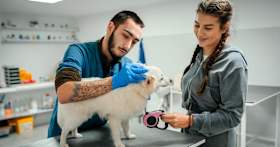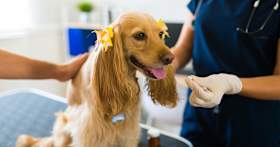Does My Dog Need a Vet? Signs Your Dog Needs Medical Attention
Here are some signs your dog needs medical attention.
Here are some signs your dog needs medical attention.
by Dr. Maria Zayas, | July 21, 2025

Georgii / Adobe Stock
Once a year, a pet parent will receive a notification from their vet that it’s time to bring their dog in for assessments, vaccinations, and lab screenings. The goals are straightforward, but what if something happens between annual visits? How do you know if your dog needs to go to the vet? Is your primary care clinic able to help, or do you need to go to the emergency room?
There is a significant difference in cost, time spent, and stress between the two. This guide will help you identify the signs that your dog requires medical attention from your veterinarian, or if they’re experiencing an emergency.
A dog should see a vet at least once a year. This allows them to stay up to date on their vaccinations and get screened for warning signs of illnesses. This also allows a vet to make age-appropriate recommendations for your dog to keep them comfortable as they grow up.
In addition to their annual, dogs on certain medications or above a certain age may require more frequent vet visits, such as quarterly or twice yearly. Check in with your veterinary team for advice about this timing.
Despite your best efforts to keep your pet healthy, the day will inevitably come when your dog becomes sick or injured in between regular checkups. The most likely reasons for a dog to see a vet outside of regular wellness care are:
Skin-related conditions, including allergies
Stomach issues (such as vomiting and/or diarrhea)
Ear infections
Eye infections
Pain, including limping
New growths
Urinary tract infections

The best thing you can do for your pup in an emergency is to identify critical symptoms and know where they can be treated.
Immediate emergency care is probably needed if your dog:
Has difficulty breathing
Is severely injured (by a long fall, being hit by a car, or is bleeding significantly)
Has a seizure for longer than three minutes
Cannot urinate
Loses consciousness
Shows signs of bloat
Has been exposed to a toxin at dangerous levels, which can be confirmed by a call to the Pet Poison Helpline
However, if your dog is showing signs of a less severe illness, it’s probably time to see a vet.
If your dog is showing the following signs, you should reach out to your vet, so they can be seen within a few days. If they can wait longer for an appointment, the veterinary team will let you know — but it’s always best to check.

Hernandez & Sorokina / Stocksy
A nauseous dog may drool excessively. They may approach and even sniff food, but choose not to eat or finish a meal. They might walk around instead of settling, get up frequently, ask to go outside, and dry retch or gag as if to vomit without bringing anything up. Or they may actually start vomiting.
When a dog effortlessly purges undigested food, this is called regurgitation. If a dog heaves with their belly, then brings up food, yellow or white liquid bile, or anything else they’ve swallowed, this is vomiting.
Vomiting is more urgent than regurgitation, especially if they can’t keep food or water down. If your dog has never regurgitated food before, and it happens more than once, let your vet know. However, if they vomit, call your vet immediately to determine if this is an emergency or if this can wait.
Diarrhea can occur after a dog eats something new (especially if it’s high in fats), when they’re stressed, or if they have a parasite, allergies, or almost any illness. Sometimes, the issue will clear up on its own. Other times, the issue might not go away without an underlying cause being treated. Be sure to check in with your vet, even if you know what triggered your pup’s bout of diarrhea.
Lethargy means your dog has less energy than usual. They may spend more time sleeping, avoid housemates, settle themselves away from everyone where it’s quiet, and skip a play session. They might also eat less, drink less, and generally seem dull or sad even when awake. Some dogs are clingy when lethargic. Others will separate themselves. But it will always seem like they are off.
Lethargy can come from dehydration, result from an upset stomach, be a sign of pain, or indicate a more serious illness. Sometimes the only way to tell what’s causing lethargy is to check a dog’s blood or through lab tests that check for parasites, anemia, and other factors.

Regular vet visits are key to keeping your pet healthy. Here’s what happens during a checkup, when to get them, and what to bring.
You know your dog best. If they tend to graze or skip meals, that can be normal for them. It’s best to assess their appetites over a week rather than day-to-day, because they may be skipping meals some days but finishing meals on other days.
Certain dogs, however, never fail to finish the food they’re offered. So, if your dog usually eats but hasn’t, or has gone too many days with a poor appetite, it’s time to reach out to a vet.
Your dog’s weight should remain mostly the same throughout adulthood. Slowly trending up or down in weight is normal as well. Since dogs mostly eat the same things every day in roughly the same amounts, if they are suddenly losing or gaining weight faster than before, this can be a sign of an issue.
In dogs, weight gain can be a sign of endocrine disorders such as hypothyroidism, or the presence of too little thyroid hormone, which leads to low metabolism. If they’re losing weight suddenly, they may have a parasite or be showing signs of cancer. For this reason, sudden weight changes should always be investigated sooner rather than later.
Any time you notice a new growth on your dog, it’s time to schedule a trip to the vet. These generally aren’t time sensitive, but it’s important for the vet to identify the growth so you know if it needs to be removed. Some cancers can even look like skin tags, so always get a new growth checked.

Tomasz Majchrowicz / Shutterstock
The surface of your dog’s eyes should always be clear and shiny. If they become cloudy, dull, reddish, or covered in any discharge (usually green and mucoid), these are signs of a problem. Be sure to reach out to your vet as soon as you notice something, so it hopefully doesn’t progress beyond repair.
Dogs can go blind without any outward signs of trouble in their eyes. So if it seems like they can’t see, but none of the above signs are present, you should still reach out to your vet.
The tell-tale signs of an ear infection are dirty, stinky ears. You may notice your dog shaking their head or scratching at their ears. In bad cases, your dog’s ear may become puffy, or they might tilt their head to one side. Cleaning their ears won’t be enough to fix an infection, so be sure to reach out to your vet at the first sign of an ear infection.
A dog asking to go out more to pee, squatting more often than usual, or crying while they urinate are all signs of a urinary tract infection or other related urinary issues. If you’re able to collect a urine sample, you may notice that it is brown, pink, red, and/or cloudy as well. These issues are just as uncomfortable for dogs as they are for people, so let your vet know if your pup is showing signs of a UTI and give them that urine sample if you have one.
If your dog strains to pee but nothing comes out, this is an emergency.

Samson Katt / Pexels
Dogs, like many other animals, tend to mask their pain. It’s partially a survival instinct, but they also tend to communicate pain differently than people do. If they are crying or whining, that lets you know that they are uncomfortable. Meanwhile, limping is always due to pain. Other signs of pain: not jumping, loss of appetite, tight facial features, or snapping at you or housemates.
It’s always good to encourage a dog to rest if they seem to be in pain. But you should also let your vet know, so they can find the source of the discomfort and get your dog some pain relief.
Dogs can have an “off” day. Small changes in temperature, mild stomach pain, poor sleep, and other factors can render a dog less active. Mild lethargy — or less of a willingness to do all their normal activities — isn’t necessarily a problem.
If, however, your dog struggles to respond to you, cannot stand easily, or sleeps significantly more than usual, this is more serious. If they show other signs of illness, or the lethargy lasts more than a day or progresses throughout the day, then they are showing signs of being sick rather than just tired. In this case, you should reach out to a vet immediately.
You should always notify your vet if your dog develops diarrhea. If your dog shows urgency before having diarrhea, if there’s blood in the diarrhea, if the diarrhea is mostly liquid, or if your dog becomes lethargic or loses their appetite along with their diarrhea, then they need to see a vet.
If a dog vomits more than once, cannot keep food or water down, has signs of blood in their vomit (such as pink, red, or other color changes), or vomits up an object, then they need to see a vet.
If you can’t afford the vet, take a deep breath first. You are definitely not alone. Many people are in the same situation. Many vet clinics want to help and might offer payment plans, sliding scale fees, deferred billing (through third-party services like CareCredit), and even if they don’t advertise it, it’s worth asking. Nonprofits, shelters, and mobile vet clinics sometimes provide options for low-cost care.
Garcia, Eric D. “Top 10 Reasons Why Pets See a Veterinarian.” Today’s Veterinary Practice, 5 Nov. 2018, todaysveterinarypractice.com/news/top-10-reasons-why-pets-see-a-veterinarian.

Dr. Maria Zayas attended Ross University School of Veterinary Medicine where she completed her veterinary degree in addition to participating in and presenting research related to aquatic animal medicine. She spent her first year as a doctor working with a low cost spay/neuter and general practice clinic before returning to her home state of New York and entering the world of housecall veterinary medicine. Falling in love with this area of medicine, she launched her own housecall veterinary practice in addition to writing pet health articles. She loves all things related to water and continues to travel and explore with her three dogs and one cat, all of whom also love to swim.

Adoption Advice

Pet Wellness

Pet Wellness

Adoption Advice
A diagnosis in a pup may seem scary. But in most cases, dogs with Lyme can live a long, normal life.

Breed Info
These cute little pups can develop not-so-cute problems. Here’s how to prevent and detect their common health issues.

Pet Wellness
If you suspect your pup may have fleas — don’t panic. Here’s how to check for them, treat them, and eliminate them.

Adoption Advice
While you’ll need to monitor your pet’s blood sugar, it’s not nearly as involved as you’d think.

Adoption Advice
Pet parenthood can be tough, but finding the right vet doesn’t need to be. These tips will help you find the right vet for your pup.

Pet Wellness
Learn about everything from prevention to treatments, for both cats and dogs.


Pet Wellness
GI issues are common, but very treatable. Here’s how to help your new dog or cat overcome their stomach problems as they settle into your home.

Behavior & Training
Sure, your dog loves chewing on sticks. But what happens if they actually start eating them?